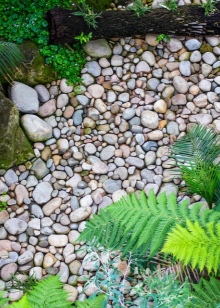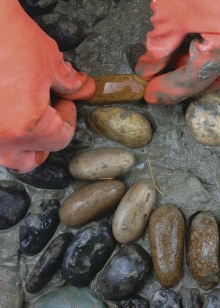How to make pebble paths?

Knowing how to make pebble paths is useful for any summer resident. Garden paths in the country with their own hands made of small and large pebbles can be both useful and decorative. But it is important to study the technology of laying a pebble path, as well as the basic principles of caring for it.



Peculiarities
Improvement in the country, even a purely utilitarian one, is very important. And so that you can walk calmly and comfortably in all main directions, you cannot do without footpaths. Many people traditionally leave them just trampled, but this is not the best solution - there will always be dust and dirt. Pebble paths will be at least as good as those built using asphalt, brick, cement mortar or wood.



Pebbles are a completely natural material with small dimensions. It is typically elongated, flat or rounded (this is determined by the specific origin of the mineral raw materials). Pebbles rolled in the sea are usually smoother than those that have been in a river or lake, more often have a mirror surface. This is due to the rhythmic effects of salty ebb and flow. It is curious that, according to some estimates, such material has an even better morphological structure than granite.

From a hygienic point of view, it is also attractive. Pebbles are always mined in an open way. Along with raw materials, you can always buy cut and polished pieces, which opens up additional design possibilities. But the very natural texture of pebbles in many cases is enough to form attractive paths. It will be easy to fit such a decorative element into any landscape design.



Choice of materials
If it is difficult to give preference to paths made of small or large pebbles, you just need to combine them. This combination will harmoniously intertwine with wood, slabs, metal, and other finishing materials used in the garden. The stone will perfectly combine visually and with ornamental plants, highlighting their advantages. As for the choice between river and sea rock, it must be pointed out that the second option, due to its smoothness, is more difficult to process and lay out.
Rough and flattened freshwater pebbles are more practical. The size of the stones also matters. The coarse fraction allows you to work faster. However, the smaller the size of the pebble, the more complex patterns and shapes you can create from it.
The pebbles itself can be taken completely free of charge on the shore of any reservoir, you can buy it in the construction market, in the online store.



Many decorators prefer to create runways from bulk epoxy bonded. These stone carpets are made in both monochrome and multi-color styles. Drawing can be both chaotic and well thought out in advance. Useful for work:
- natural smooth pebbles;
- artificially processed material;
- small crumb.


Along with epoxy, polymer resin can also be used. The binder is most often completely transparent, but it can also be colored to maximize the effect. In some cases, amber pebbles are used. It is usually made of the highest grade Baltic yellow amber. Finally, it is worth mentioning such a solution as pebble paths with polymer as a binder.
Marble pebbles are in great demand in landscape design. This material is a by-product of marble processing.The debris is polished and carefully sanded to achieve a smooth surface. White pebbles, usually harvested in mountainous areas, are almost ideal for garden paths. The most convenient way, according to most professionals, is to use washed pebbles, which are easier to assemble, since they are devoid of unnecessary impurities.


The main pebble-forming rocks, in addition to marble, can also be:
- granite;
- mica;
- feldspar;
- sandstone;
- gypsum;
- slate;
- quartzite.


DIY styling technology
The very first step is digging a trench, the depth of which is 0.3 m.A pillow is laid on its base. Do it step by step like this:
- pour 0.1 m of sand;
- compact this mass;
- add 0.05 m of crushed stone.



Already at this stage, it is important to take care that the track does not subsequently creep and deform. Therefore, you should immediately lay the curb stones. They are leveled at the building level and clearly fixed along the edges of the path. The gaps are poured with a concrete mixture formed by 3 parts of sand, 1 part of cement and 3 parts of water. The filling is carried out exactly in accordance with the future height of the curb.
Instructions for creating a pebble sidewalk path for home and garden says that immediately after that you can lay out the material itself... Each piece is embedded in concrete exactly to the middle in thickness. It is recommended to leave as few gaps as possible. Monolithic pebble carpets usually look more attractive. The formation of a complex pattern will be greatly facilitated if you fold it in advance on the nearest free area and symmetrically transfer it to the track itself.



The stones are usually trimmed during the paving process using a long, straight plank that is laid across the path. You should lightly hit this board with a mallet. The accuracy of the calculation is verified using the building level. Having prepared the entire structure, it is necessary to close it with plastic wrap for 24 hours. Next, you need to make a putty with a liquid consistency, which includes 3 parts of sand and 1 part of cement, optionally adding a dye.

Such a composition is poured onto the track, where it itself is distributed over the surface, closing the cracks. To remove excess, use a foam sponge. After that, you will have to leave the preparation of the track alone for another 15 days. Until the end of the wait, it should be covered with polyethylene again. Further, you can already use the path quite calmly.


Advice:
- put plastic wrap or roofing paper on the very bottom after laying the pillow;
- place the pebbles in the solution without undue effort;
- increase its adhesion to the solution by pre-wetting;
- put everything in separate areas, because the solution quickly sets;
- fill the cracks with a more liquid solution;
- sprinkle or wet the track with water twice during drying;
- clean stones from mortar using a moderately hard steel brush;
- to make ornaments not by eye, but using templates and sketches.



Track maintenance
Just making a pebble path is not all. It is also necessary to take care of her, even if this process is very simple. Rock chips are not too dangerous and can be ignored. Be sure to weed out growing grasses and other shoots. You will also have to sweep the debris.
If the path is lined with shale pebbles, it is systematically treated with a hydrophobic compound. Otherwise, the stone will crumble and will not last long. Thorough drainage and thoughtful drainage help to prevent the washout of small stones. The preliminary geotextile flooring will also be a kind of maintenance measure. Snow can be removed using conventional shovels and scrapers.


A small amount of snow is swept out with brooms, brooms. If the garden is large, it is better to use a snow blower. For cleaning in the warm season, blowers and vacuum cleaners are used. Snow must be removed not only from the track, but also next to it.After removing the bulk of the snow, even small residues must be swept out in order to exclude the appearance of ice.
It is undesirable to remove it with a shovel and crowbar. This will break the relatively fragile coating. Treatment with reagents is possible, but you will have to fear for the safety of shoes and risk disrupting the fertility of the nearby land. It is best to use sand. In large areas, it is more correct to use heating, although it is not so cheap.


Examples in landscape design
- The photo shows how nice a combination of large white and small darker pebbles can look in different sectors of the path.

- But this does not mean that you can only experiment with shades of one color. On the contrary, the combination of white and red parts of the gamut is perceived very well.


- The use of pebbles can be even more intricate in appearance. This photo shows just such an exceptionally colorful "carpet".



How to make pebble tracks, see the next video.













The comment was sent successfully.